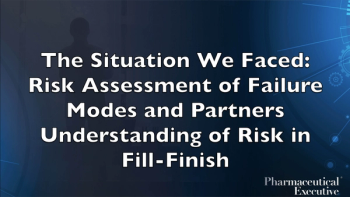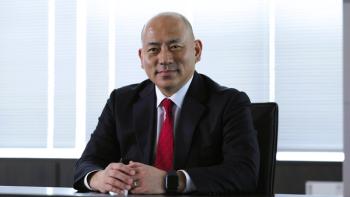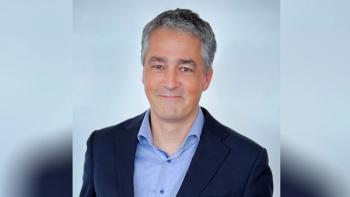
- Pharmaceutical Executive-07-01-2011
- Volume 0
- Issue 0
Precious Mettle
Taking Onyx Pharmaceuticals to new heights – CEO Tony Coles talks to PharmExec about the midsize company's transition from adolescence to adulthood.
Coming up on its 20th anniversary as a midsize biopharma company focused on innovative cancer therapies, Onyx Pharmaceuticals today faces that awkward transition from adolescence to adulthood. This year, the company's prime asset—Nexavar, comarketed and developed with Bayer—is likely to become a blockbuster drug, a significant milestone in itself at a time when the blockbuster model is fraying as a driver of organic growth. The company holds a cash reserve of nearly $600 million, ready to deploy for the right deal, and recently cut the tape on a new, high-profile headquarters next to the fabled Genentech facilities in South San Francisco. But the truly transformative element, the one that could validate the strategy of CEO Tony Coles and take the company to the next level, resides in another next-generation breakthrough cancer product: carfilzomib. It's the company's key bet on the future and the outcome depends heavily on the pace of the expected NDA filing in the next few months, followed by accelerated FDA approval in 2012.
"Tony has done a good job in acquiring carfilzomib, instead of having the company totally rely on Nexavar," says Howard Liang, managing director, biotechnology analyst, at Leerink Swann. Carfilzomib, along with two other compounds, arrived through the acquisition of Proteolix, a deal done in 2009, Coles' second year on the job. Liang says the deal was "structured right," with the largest payment hinging on commercial approval.
A selective proteasome inhibitor for multiple myeloma, carfilzomib could get that crucial marketing authorization as early as next year. Some analysts are whispering about the drug's blockbuster potential. A carfilzomib approval would augur well for additional success; with an orally formulated proteasome inhibitor in the pipeline, Onyx could bring a franchise to bear on one of the most deadly forms of blood cancer. "I think investors are primarily interested in the different applications of carfilzomib ... there's a lot they can do with that franchise," says Liang. "But I think the company has a fair amount of work to do."
Onyx's desire to develop and sell its proteasome inhibitor therapies in-house is a departure from the strategy of Hollings Renton, Coles' immediate predecessor. Where Renton was content to make his mark in early discovery, letting companies like Bayer and Pfizer juggle the intricacies of later-stage development and commercialization, Coles is determined to keep his products in the family, at least to the extent that he can. "Now that cancer has become such a hot area, we have no lack of pharmaceutical companies that are interested in helping us with geographic expansion," he says. "We can scale it in the US, and we can probably scale it in the Western markets." Self-commercialization, in Coles' view, is Onyx's step stool.
"This sounds cliché, but I do mean it: I really don’t know how you put a price on additional time for someone’s life."
Sales of oncologic drugs grew by 6.7 percent in 2010, to $56 billion—the biggest single market segment—but most companies don't succeed by virtue of market opportunity alone. Coles' focus on the cancer space, and his decision to channel resources into blood cancer treatments in particular, stems in part from his personal experience with the disease; his eldest son was diagnosed with non-Hodgkin's lymphoma at the age of 13. That emotional connection demonstrates that succeeding in this business is not only about PowerPoint presentations; it's also about passion. In fact, Coles' elevator speech about Onyx emphasizes "transformation" geared to making progress against unmet medical need. "If we can transform the profile of cancer through new therapies, we will transform our company as well," Coles told Pharm Exec. "As we unlock the understanding of cancer and make it a chronic condition"—as opposed to a uniformly fatal one—"then we will have the opportunity to transform peoples' lives. That pays back to the company and what we do on behalf of our customers and shareholders."
Onyx launched a new corporate logo in March, a circle or sphere comprised of two three-dimensional curls reflecting a theme of "convergence:" dedication to science linked to a compassion for patients. The theme plays forward around the company's three key business objectives: assisting Bayer in building Nexavar's commercial growth and supporting new clinical investigations; advancing clinical development on carfilzonib; and working on its pipeline with a focus on near- and long-term growth potential.
Onyx's current executive team was mostly brought on after Coles became CEO. Matthew Fust, EVP and chief financial officer, joined the company in 2009, from Jazz Pharmaceuticals. Juergen Lasowski, EVP, corporate development and strategy, was a colleague of Coles at NPS Pharmaceuticals. He joined two months after Coles' arrival. Ted Love, in charge of the crucial task of clinical development, joined Onyx in 2010, having worked at Genentech for six years.
Priming the Personal Connections
After completing medical school at Duke, and getting married, Coles did his residency at Boston's Mass General, training in internal medicine and cardiology. He also managed to pick up a public health Master's from Harvard, and had two children. Then he got a call from Merck. "I had started thinking about working on population-based healthcare as a result of the public health degree, and got the notion that there were other ways to impact lives than just provide patient care," says Coles. "I thought about a career on Capital Hill as a healthcare policy staffer; Merck called out of the blue." As chair of the Minority Recruitment Committee at Mass General, Coles' activities had sparked the interest of Merck, specifically then-CEO Roy Vagelos. "Merck was very interested at the time in building a pipeline of minority scientists," says Coles. That interest turned into a three-year corporate grant to fund summer research internships at Mass General, and during that time, Coles received the aforementioned call: "Would you ever consider working for us?" Merck wanted to know. The offer came "at just the perfect time," says Coles, adding that Vagelos is "a big part of the reason that I'm in the industry."
"Roy had a really neat idea that physicians could be good business people, and had built a small team of physicians who had a business interest or direct marketing experience," recalls Cole. His first assignment at Merck was in the company's customer marketing group, where he got to learn the products, and work closer to the customer. Four years later, Bristol-Myers Squibb recruited Coles to help manage its partnership with Sanofi, and to launch Plavix and Avapro globally. "You only get to launch products very rarely in a marketer's life, so it was a dream come true," he says. As Coles' career blossomed at BMS—toward the end of what he refers to as his "middle decade" with Big Pharma—he began to contemplate the next 10 years, with an eye toward the biotech industry.
Enter Chaos
One day, Coles' son Andrew started complaining about pain in his left arm. The pediatricians couldn't find anything. "It wasn't until he woke up one morning and his sternum was actually protruding that we realized something was really seriously wrong," says Coles. During an evaluation, Andrew developed a variety of symptoms, including blood in the urine. That led to an evaluation of his kidneys, which uncovered "a huge mediastinal mass" in his chest. "One of the few rare emergencies in pediatrics is a compromising mediastinal mass, because of its proximity to the vital structures, including the trachea and other things, and [cardiac] arrest is not all that uncommon in these far-gone stages," says Coles. "Our physician said, 'Do not delay. I want you to go to Sloan-Kettering tomorrow morning and be there at 9 a.m. I've arranged for them to receive you.'"
At the time of diagnosis, Coles was interviewing at Vertex Pharmaceuticals, where he'd been recruited to head up the company's commercial operations. "To receive a phone call from my wife in the middle of business meetings is highly unusual, and I knew something was wrong, so I jumped on an airplane and headed home," says Coles. At Sloan-Kettering the next morning, it was determined that an emergency biopsy and surgery were needed. Andrew's pathology report came back with non-Hodgkin's lymphoma.
Most people can recall easily where they were on Sept. 11, 2001. Coles was at Sloan-Kettering in Manhattan, where his son was having a spinal tap and receiving chemotherapy. "One of the aides in the hospital walked in and told us that the buildings had been hit, literally as Andrew was coming out of anesthesia. And the fascination with what was happening, combined with Andrew's situation, was really surreal for us," says Coles.
After six cycles of chemotherapy, Andrew's cancer went into remission. "I took the job at Vertex, because I thought our life had suddenly been clarified, only to find out after I started at Vertex, six weeks later, that Andrew had relapsed, and we were told that he needed to have a bone marrow transplant. And I can tell you that I learned more about our industry through that episode than I had learned in the previous decade before that," says Coles. "The thing I recognized was the enormous value that we bring into the lives of people. Not just from a health point of view, but in easing the burden on their loved ones as well. When I went to give Andrew an injection of Neupogen, which he needed after his first cycle of chemotherapy, I recognized at the moment when I held that vial in my hand that this was really a life-giving opportunity for my son, potentially. I know it sounds dramatic, but it hit me in a way that had not occurred to me before."
Renewed Focus
Andrew is doing fine now, but the experience left a mark on his father. After a three-year stint at Vertex, Coles resigned in 2005 and took a job as CEO at NPS Pharma, before joining Onyx, a company focused almost exclusively on developing cancer treatments, in 2008.
On the divide between Big Pharma and biotech, Coles says Big Pharma companies "are superb at marketing and distribution and commercialization." In contrast, the biotech industry has "become expert at discovering new compounds, both large molecules and small molecules." Combining a biotech with a large pharma "would almost make a perfect company, because you'd get the innovation of one with the scale and the distribution capability of the other," says Coles. "But the two really have grown up quite differently. Nevertheless, I think biotech is now beginning to emerge as a commercial powerhouse within the industry as well."
Carfilzomib was supposed to be filed with the FDA in late 2010, but the submission was delayed after Onyx scaled up its manufacturing process in anticipation of approval and launch. The clinical profile of the drug didn't change, but FDA's Chemistry, Manufacturing and Controls (CMC) division requested additional information about its manufacturing capabilities involving "minor variations," primarily related to "equipment temperature variances," according to a company statement. Not surprisingly, Coles puts a positive spin on the delay. "As it turned out, [delaying an NDA filing] was a wise decision. What we really want is a high-quality NDA ... and we've done several things to strengthen our case. We filed for and received fast-track designation in January, and that's very good because it does two things: It allows us to submit the NDA on a rolling basis, and as a result, we've submitted the first of three modules, which is the non-clinical piece covering animal studies and toxicology," says Coles. "The second piece is the clinical module, and the third is the CMC module." Fast-track rolling submissions "help to reassure investors that we are on track for filing the NDA as early as the middle of this year." Last month, Ted Love, EVP and head of research and development and technical operations at Onyx, said the NDA would be submitted in the "July to August" time frame. The company is betting on accelerated approval, and plans to launch first in the US without the aid of a partnership.
Carfilzomib's success depends on a couple of factors, including how soon it gets to market, and "how far ahead it comes to the market relative to generic Velcade, which is the lead product in the class," says Liang. "It also may hinge, to some extent, on how widely the newer forms of Velcade are adopted. One of the differentiating factors for carfilzomib is low side effects and low neuropathy, and that can be reduced for [Millennium/Takeda's] Velcade, by dosing it less frequently, so instead of twice a week, there has been a weekly Velcade dosage that has shown reduced neuropathy." Even so, Liang says carfilzomib "probably still offers a preferable [risk] profile," with very low incidences of neuropathy.
Overall, analyst Liang is a bit less optimistic than Coles as to the ultimate outcome: "Whether carfilzomib gets accelerated approval is still questionable," he says.
In addition to carfilzomib's beneficial risk profile, Coles says standard therapies "only succeed in this very sick [multiple myeloma] population about 10 percent to 11 percent of the time. We believe that the clinical data from the study we're filing on [Phase IIb 003-A1], which showed that we more than doubled that overall response rate, from 11 percent to 24 percent, is very strong. Also, the overall survival in this particular study was 15.6 months, compared to six to nine months with the currently available therapies." Those data refer to patients that have relapsed and are refractory to most new therapies.
Last December at the American Society of Hematology meeting in Orlando, Fla., Onyx announced data on carfilzomib from a study done with newly diagnosed patients that had never been treated with any drug. The study, conducted by the University of Michigan's Comprehensive Cancer Center, found that patients given carfilzomib in combination with Celgene's Revlimid (lenalidomide) and a steroid called dexamethisone, had an overall response rate of 100 percent after four cycles of therapy, says Coles. Of that 100 percent response after four cycles, 36 percent of the patients had a complete response, meaning no disease detected. After eight cycles, 67 percent of the patients had a complete response.
Onyx's Phase III ASPIRE trial, initiated a year ago, is also testing the same triple combo—carfilzomib, Revlimid, and low-dose dexamethisone—in patients with relapsed multiple myeloma. Another Phase III trial, FOCUS, is testing carfilzomib as a single agent in treatment-refractory patients with relapsed disease. "We think that cancer in general is a tough disease to cure, but in a uniformly fatal disease like multiple myeloma if we can give patients hope that, like with diabetes or hypertension, their lives can be extended and myeloma can become a chronic disease, we will have made an important contribution to the field of medicine," says Coles.
Product to Portfolio
Multiple myeloma is currently a $4 billion market, and is expected to grow to more than $7 billion by 2015. Over 215,000 people worldwide are currently living with multiple myeloma, and roughly 86,000 are diagnosed each year. The deal with Proteolix, including an oral proteasome inhibitor (ONX 0912), and an immunoproteasome inhibitor (ONX 0914), was structured favorably for Onyx, says Liang, allowing the company to provide a "modest upfront"— $276 million—"and then pay [up to $535 million] on the success of the back end, as the compound receives regulatory approval." An additional development milestone payment of $40 million was made in 2010, bringing the total cost of the deal to $851 million, assuming US and European approval on carfilzomib. Unlike Nexavar, whose profits and development costs Onyx splits 50/50 with Bayer, (with the exception of Japan, where Onyx gets a royalty), Onyx owns worldwide rights to carfilzomib. Liang cites that strategy as the right one for the new Onyx. He cites Celgene and Alexion as two examples of companies "that have done well, at least from a market valuation perspective," by holding on to US as well as worldwide rights.
With Nexavar (sorafenib) bringing in close to $1 billion dollars annually in global revenues—sales were up in 2010 by 11 percent, to $934 million—Onyx can afford to put substantial investment into developing its pipeline. Pfizer's investigational drug axitinib could take a bite out of Nexavar's profits if it's approved—a Phase III head-to-head trial showed axitinib besting sorafenib in terms of extending progression-free survival in kidney cancer patients by two months—but Nexavar is also in the clinic for additional indications, including thyroid, breast, ovarian, and colorectal cancers. The drug has produced disappointing results as a treatment for non-small-cell lung cancer and melanoma, but Onyx anticipates up to five new filings for Nexavar over the next two to three years, the company says. Additionally, gains have been made on the global front, thanks to Bayer's network strength and reimbursement finesse. Bayer won reimbursement coverage for Nexavar's liver cancer indication in South Korea late in 2010, and hopes Taiwan will follow suit this year.
Bayer and Onyx have also targeted non-oncology specialists who see patients with liver cancer, including hepatologists and gastroenterologists. These specialists have been eager to play a role in treatment, but had nothing other than hospice care at their disposal, says Coles. "It became clear that we were capturing patients once they got to an oncologist, which is our traditional call audience, but we wanted to try to identify patients earlier, at the moment of diagnosis," he says. Oncologists treat most cancer patients, but with liver cancer, it's a cross-functional team of physicians, says Coles.
The recognition that non-oncologists are identifying and diagnosing liver cancer, and that these non-oncologists are willing to write Nexavar prescriptions, was an insight Coles attributes to his background in marketing. "The hepatologist audience has been incredibly receptive to the educational messaging around Nexavar, and the role that Nexavar can play," says Coles. Outreach to this audience—which also includes surgeons and interventional radiologists—includes a mix of direct detailing, educational efforts and symposia, and has doubled Nexavar prescription volumes within that audience over the last three years, says Coles.
Expanding the Portfolio
Right now, Onyx's priority is to get the carfilzomib NDA filed, but the company is also looking down the road, at portfolio development and opportunities in markets beyond the US. While Coles is keen on keeping his proteasome inhibitors close to the vest and building Onyx's commercialization capabilities, he recognizes that the scale of investment required in certain geographies is a hurdle for a company with just 300 employees. "It's the Asia-Pacific markets that present an interesting conundrum ... We think Big Pharma's partnership help in those markets still makes a lot of sense," says Coles.
To address the problem of commercialization in Japan, Onyx signed an exclusive agreement with Osaka-based Ono Pharmaceutical Co. last September, to develop and commercialize carfilzomib and ONX 0912, an oral proteasome inhibitor currently in Phase I. The deal came with an upfront payment of roughly $59 million, and the potential for another $280 million based on "development and sales-based payments related to the compounds." Onyx is also entitled to "royalty payments in double-digit percentages on net sales in Japan, commensurate with a late-stage asset," according to a statement on the deal. "This was the best way into the Japan market for us," says Coles. We have a similar point of view for Latin America and Asia-Pacific." The company is actively looking for partners in those territories.
From a business perspective, the US cancer space beyond Nexavar is "a great entry point for a company our size, because it's all scalable. You can have a modest number of field-based personnel and they can reach the target audience very effectively, with messages that the [specialist audience] really wants to hear," says Coles. Onyx is also "analyzing all of the ways in which we can get into Europe," which includes partnering for a limited time, while building infrastructure, or launching in the top five territories as a single company, "but the goal is to retain significant downstream value for the compound in Europe," says Coles.
Adding to carfilzomib, ONX 0912 gives Onyx "the opportunity to have a franchise in multiple myeloma," says Coles. ONX 0912 will enter Phase II later this year, and despite this early stage of development, Coles says the drug is "active and bio-available," and the degree of proteasome inhibition in patients with solid tumors "is comparable to carfilzomib." If proteasome inhibition is a proxy for efficacy, and Coles thinks it is, "we could have a highly efficacious oral drug on our hands," he says.
In the run-up to carfilzomib's expected NDA submission, Onyx decided not to exercise an option on two janus kinase (JAK) inhibitors from S*Bio, a Singapore-based biotech. That deal was first announced in January 2009, and expanded in 2010 (Onyx paid $25 million upfront, and another $20 million when the deal was expanded in May 2010), but was cancelled in May of this year. The original deal was worth up to $550 million total, but Onyx decided to put its energies and resources into carfilzomib, the company said. Despite numerous ongoing clinical activities, with proteasome inhibitors (Onyx's immunoproteasome inhibitor, ONX 0914, which would potentially target autoimmune diseases like rheumatoid arthritis, lupus, and psoriasis, is a first-in-class therapy currently in the preclinical phase), and development costs in support of additional Nexavar indications, the company is fairly well-heeled. At the end of 2010, the company had $578 million in cash, a respectable figure, according to Laing. Coles says Onyx will "keep an eye out for the next great opportunity in the oncology space."
Endpoints
Given the level of competition in the cancer market, the high cost of treatment, and the ability to raise an innovative drug's price tag—the price of Nexavar was increased four times, by a total of 18 percent, between January 2008 and the summer of 2009, Bloomberg reported—it's important to know exactly what kinds of data and endpoints the FDA finds most meaningful in terms of granting approval. "Oncology is really going the way of cardiology, in terms of evidence-based medicine," says Coles. "In the '90s, we moved through various clinical proxy endpoints in cardiovascular research until we finally got to a reduction in mortality—overall survival—as the gold standard. And cancer seems to be following the same order.
"We think it's actually very clear in terms of the endpoints that are useful for FDA. We think progression-free survival and overall survival are both appropriate endpoints," says Coles. "Overall survival data is desirable and if it can be gathered, then that's the gold standard." However, progression-free survival is still a "solid" endpoint, and "will likely be acceptable for approval in most cases," he concludes.
Discussions about the length of survival provided by a given drug, as an approval metric or for a decision on reimbursement, are fraught with emotion and tough philosophical implications. The primary study that Onyx is using for its NDA filing on carfilzomib— Phase IIb 003-A1—showed the drug gave patients an additional six months to live, compared with currently available therapies. "This sounds cliché, but I do mean it: I really don't know how you put a price on additional time for someone's life, quite candidly," says Coles. On a recent trip, "the woman who was helping us check into the hotel noted that we were from Onyx, and she said, 'I just want to thank you, because my father had liver cancer, and he took Nexavar, and while he only had a small amount of time left by the time he was diagnosed, we are so grateful to you, for giving him that additional time with us.' Speaking in the abstract is one thing, and of course we have to have policies that govern the way we pay for things and reimburse, but everyone who is a decision-maker in this industry really should have an up close and personal experience with a life-threatening disease," says Coles.
For everyone at the company, the approval of carfilzomib—or lack thereof—will be a defining moment; Nexavar's patent is good until 2020, but if Onyx wants to "chart an independent course" based on its proprietary pipeline, as Coles says it does, it will need to deliver on its proteasome inhibitors commitments in the shorter term.
That said, Nexavar has generated promising Phase II clinical data for thyroid cancer, suggesting improvement in both progression-free survival and overall survival. In June, however, the drug failed to improve overall survival as a monotherapy for lung cancer, but it did prolong progression-free survival. Bayer said in a statement that it would continue evaluating Nexavar as a monotherapy, and in combination with targeted agents, for later lines of lung cancer treatment. In total, Nexavar has seven Phase III trials under way, including one for patients with metastatic breast cancer that is HER2 negative—a breast cancer representing 75 percent of all cases, according to Coles. Phase II data, published in 2009, demonstrated a 74 percent improvement in progression-free survival for HER2 negative breast cancer, compared to an active treatment population. Expanding Nexavar's label and maximizing sales for that drug would go a long way toward providing the funds needed to bring Onyx's next cancer drugs to market.
Articles in this issue
over 14 years ago
Pharmaceutical Executive Digital Edition - July 2011over 14 years ago
What the 2011 Census of India Reveals for Pharmaover 14 years ago
Holy Surge of Enthusiasm!over 14 years ago
New Ways to Gain New Brand Insightsover 14 years ago
Poland: A Sleeping Giantover 14 years ago
Planning Beyond the Petri Dishover 14 years ago
Truth Found in the Wrong Placesover 14 years ago
How to Prevent a Facebook Faux PasNewsletter
Lead with insight with the Pharmaceutical Executive newsletter, featuring strategic analysis, leadership trends, and market intelligence for biopharma decision-makers.





